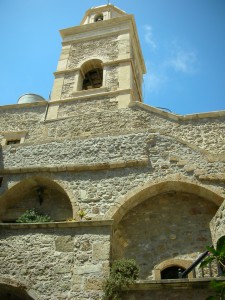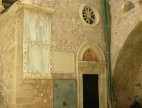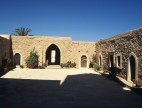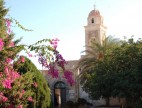Holy Monastery of Toplou
The monastery of Toplou or the Akrotiriani [All-Holy Virgin of the Cape], as it is called due to its position in the eastern corner of Crete, is one of the most renowned and important monasteries of the island. Its establishment probably dates to the late 14th century, a period during which the original catholicon was erected, dedicated to the Birth of the Theotokos. The monastery acquired its fortified form after its systematic plundering by Turkish pirates that raided eastern Crete at the end of the 15th century. Its reconstruction is connected to the Venetian-Cretan families of the Kornaroi and the Metzoi of Siteia according to tradition. The great earthquake of 1612 caused serious damage to the monastic complex, which was restored anew by the scholar abbot, Gabriel Pantogalos, and with the contribution of the Venetian state. The church of the All-Holy Virgin was extended in this period with the expansion of the original aisle and the addition of the aisle of St. John the Theologian to the south. According to the historical testimonials, the 17th century was a period of prosperity for the monastery that possessed large property, not only in eastern Crete, but also in the city of Chandakas. During the Turkish occupation, its function continued seamlessly, despite the fact that it endured many raids and damages, due to the participation of its monks in the liberation struggles. Its building complex, with a strong fort-like character, develops on three floors around a small courtyard to the south side of which is located the catholicon. The renaissance, two-storey belfry which rises on the roof of the western wing and the façade of the catholicon in which ancient, and contemporary with its erection, inscriptions have been embedded, such as that of the abbot, Gabriel Pantogalos, in elegiac couplets, are characteristic of the period during which the monastery received its final form. The interior of the catholicon whose original building today occupies the place of the sanctuary, presents special interest and has wall painting decoration of the second half of the 14th century with scenes from the cycles of Christ and the All-Holy Virgin. Several excellent icons are displayed in the church, such as Christ Pantocrator of the second half of the 15th century, which is connected with one of the most important painters of the Cretan School, Andreas Ritzos, and the icon “Great Art Thou, O Lord…” of 1770 of the painter Ioannes Kornaros, in which is depicted almost the total of the verses of the prayers of the Great Blessing of the Waters. Important icons, manuscripts, early printed books, and engravings that cover a lengthy period, from the 15th to the 19th centuries, are displayed in the two adjacent spaces of the basement of the monastery that are arranged as a museum.







